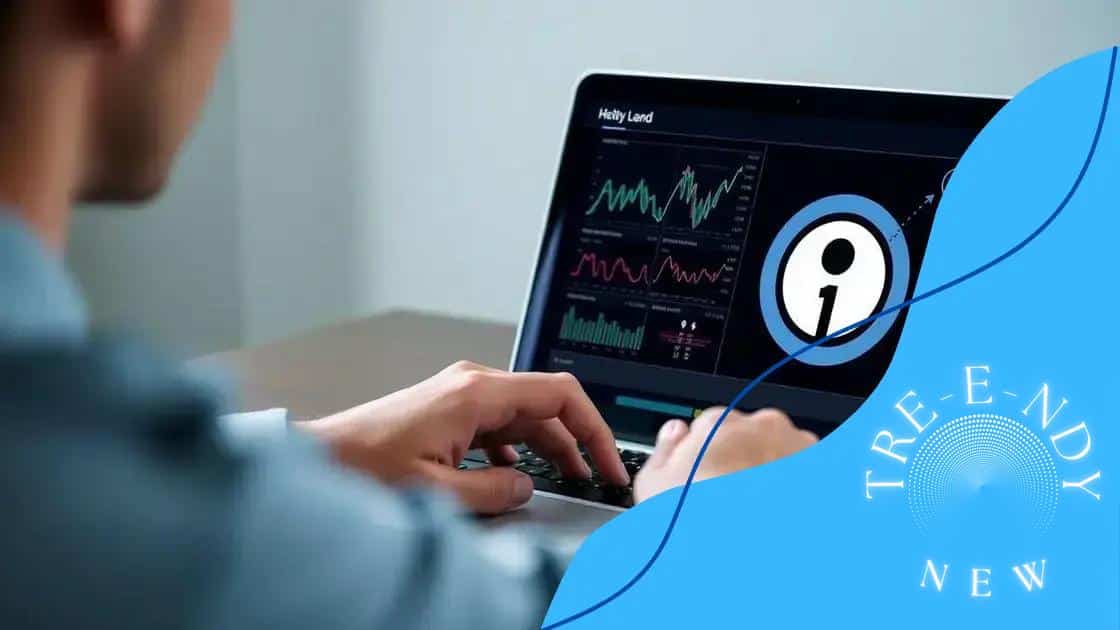The growth of peer-to-peer lending in 2025

The growth of peer-to-peer lending in 2025 will provide borrowers with lower rates, faster access to funds, and enhanced personalized options through advances in technology like AI and blockchain.
The growth of peer-to-peer lending in 2025 is something worth considering. Have you ever thought about how this model could impact your finances? Let’s dive into the fascinating changes it promises to bring.
Understanding peer-to-peer lending
Understanding peer-to-peer lending is crucial for anyone looking to navigate the evolving financial landscape. This innovative approach allows borrowers to connect directly with lenders, often via online platforms. With technology at the forefront, traditional banking barriers are being broken down.
What is peer-to-peer lending?
At its core, peer-to-peer lending enables individuals to lend and borrow money without the involvement of traditional financial institutions. Platforms like LendingClub and Prosper facilitate these transactions, matching lenders with borrowers.
This model allows for competitive interest rates, benefiting both parties. Borrowers can access funds quickly, while lenders can earn returns on their investments. It’s a win-win situation that has gained traction over the last few years.
Benefits of peer-to-peer lending
- Lower costs: Typically, fees are lower compared to banks.
- Fast processing: Many loans are approved quickly and funds are transferred faster.
- Flexibility: Borrowers have more options and can negotiate terms.
- Opportunities for lenders: They can support individuals and potentially earn higher returns.
As the growth of peer-to-peer lending continues, more people are recognizing its advantages. The speed it offers can be crucial for borrowers in need of immediate funds. Plus, lenders can feel good about supporting others directly, creating a sense of community.
Moreover, as platforms expand their services, they often provide additional resources such as credit scores and financial education. This allows borrowers to make informed decisions, fostering a more knowledgeable lending environment. However, as with any investment, it’s essential to consider the risks involved.
Who can benefit from peer-to-peer lending?
This model is not just for those with bad credit. Many people opt for peer-to-peer lending for the convenience and competitive rates available. It’s an attractive option for personal loans, business financing, and even student loans. As more individuals become aware of peer-to-peer lending, its popularity is expected to surge, particularly among younger generations.
In summary, understanding peer-to-peer lending opens doors to new financial opportunities. With the right information and tools, both borrowers and lenders can take advantage of this evolving marketplace. The future looks promising for this unique lending approach.
Key players in the market
In the peer-to-peer lending landscape, several key players shape the market. Understanding who these players are is essential for both borrowers and lenders. The platform providers, regulatory bodies, and investors all play vital roles in this dynamic ecosystem.
Platform Providers
One of the most significant groups in this market is the platform providers. Companies like LendingClub and Prosper act as intermediaries, connecting borrowers with individual lenders. These platforms facilitate the loan process, provide risk assessments, and often automate many aspects of the lending experience. They make it easier for users to apply for loans and receive funds.
Regulatory Bodies
Regulatory bodies are essential to ensure that peer-to-peer lending operates within legal frameworks. In the United States, the Securities and Exchange Commission (SEC) oversees these platforms to protect consumers and maintain market integrity. Their rules help in establishing trust in the system, which is crucial for its growth.
Investors also play a central role in this space. Individual lenders can choose to back different borrowers based on their profiles and risk assessments provided by the platforms. This flexibility allows them to diversify their investments while supporting individuals and small businesses in need of capital.
Market Impact
- Competition: Increased competition among platforms often leads to better rates and terms for borrowers.
- Innovation: Key players invest in technology to enhance user experience and improve risk assessment methodologies.
- Global Reach: Many platforms are expanding their services internationally, broadening their customer base.
As new players enter the market, the dynamics will continue to shift. This ongoing evolution presents opportunities and challenges for everyone involved. By closely monitoring these key players, individuals can make informed decisions whether they are looking to borrow or lend.
Impact of technology on peer-to-peer lending

The impact of technology on peer-to-peer lending cannot be overstated. Modern innovations have transformed how borrowing and lending occur, making the experience faster, safer, and more efficient. Technology not only streamlines processes but also enhances accessibility for both borrowers and lenders.
Enhanced Data Analytics
Data analytics plays a significant role in assessing borrower risk. By leveraging advanced algorithms and machine learning, platforms can analyze vast amounts of data to provide more accurate risk assessments. This means lenders can make informed decisions, while borrowers may receive better rates based on their individual profiles.
User Experience Improvements
Many peer-to-peer lending platforms have invested in user-friendly interfaces. This improvement makes it easier for anyone to navigate the lending process. Online applications and clear instructions reduce confusion, allowing borrowers to submit requests quickly and easily. Additionally, features like chat support help users get assistance in real-time.
Security Enhancements
Security is paramount in financial transactions. Many platforms utilize encryption and other technologies to ensure that personal and financial information is protected. Secure transactions build trust among users, encouraging more people to engage in peer-to-peer lending.
Real-time monitoring and automated fraud detection systems further bolster security. These technologies analyze transactions for suspicious activity, ensuring that both lenders and borrowers are safeguarded against potential fraud.
Global Connection
Another significant impact of technology is the ability to connect borrowers and lenders from all around the world. Unlike traditional banks, which often operate within geographical limits, peer-to-peer lending platforms are not confined to a specific area. This global reach opens up a plethora of options for borrowers seeking funding and lenders looking for opportunities.
As technology continues to evolve, so will the peer-to-peer lending market. The integration of financial technology not only enhances the current landscape but also paves the way for future innovations. Staying updated with these advancements can be beneficial for participants in the lending space.
Benefits of peer-to-peer lending for borrowers
Peer-to-peer lending offers numerous benefits for borrowers. This innovative lending model provides individuals with access to funds without going through traditional banks. Understanding these advantages can help borrowers make informed financial decisions.
Lower Interest Rates
One significant benefit is the potential for lower interest rates. Since peer-to-peer lending platforms connect borrowers directly with lenders, they can often offer rates that are more competitive than those provided by traditional banks. This is especially beneficial for borrowers with good credit, who may qualify for favorable rates.
Quick Access to Funds
Borrowers can typically access funds more quickly through peer-to-peer lending platforms. The online application process is streamlined, which means that borrowers do not have to wait weeks for approval. Instead, many loans can be funded within a few days or even hours, making it an attractive option for those in urgent need of cash.
Flexible Loan Amounts and Terms
Another key advantage is the flexibility in loan amounts and terms. Borrowers can often choose how much they wish to borrow and the repayment period that works best for them. This level of customization allows individuals to find solutions that fit their unique financial situations.
- Personal loans: Suitable for various personal expenses, including weddings or vacations.
- Debt consolidation: Borrowers can combine multiple debts into one manageable loan, potentially reducing overall payments.
- Business funding: Entrepreneurs can access capital to start or grow their businesses with less red tape.
Moreover, peer-to-peer lending platforms often provide transparency regarding fees, making it easier for borrowers to understand the total cost of their loans. This clarity helps borrowers to budget effectively and plan their repayments.
Additionally, many platforms also offer resources and tools to educate borrowers on financial management. This guidance can empower borrowers not just to secure funds, but also to improve their overall financial health.
Future trends in peer-to-peer lending
Future trends in peer-to-peer lending are shaping the financial landscape in exciting ways. As technology evolves and user preferences change, this sector is set to experience significant developments. Understanding these trends can help both borrowers and lenders adapt to the new environment.
Increased Use of Artificial Intelligence
Artificial Intelligence (AI) is poised to play a major role in the future of peer-to-peer lending. By using AI algorithms, platforms can enhance risk assessment and personalize loan offers. This means borrowers might see more tailored loan options, while lenders can benefit from improved analytics for better decision-making.
Blockchain Technology
Blockchain technology offers a new layer of security and transparency in transactions. With decentralized record-keeping, both borrowers and lenders can trust that their information is secure. This trend may encourage more users to embrace peer-to-peer lending due to its enhanced credibility and reduced risk of fraud.
Expansion into New Markets
As more people become aware of the benefits of peer-to-peer lending, platforms are likely to expand into new geographic markets. This growth can provide increased access to funds for underserved populations, bridging the gap between lenders and borrowers on a global scale.
- Diverse Loan Products: Expect to see a broader range of loans tailored for different needs such as mortgages, business loans, and even educational funding.
- Integration with Other Fintech Services: Platforms may start integrating services like digital wallets and investment management to create a seamless user experience.
- Focus on Sustainability: More platforms are likely to consider sustainable lending practices, supporting green projects and ethical investments.
Moreover, as regulatory bodies catch up with these innovations, we can expect clearer guidelines that protect consumers while fostering growth within the peer-to-peer lending space. This balance between regulation and innovation will be crucial for the industry’s future.
Overall, the future of peer-to-peer lending looks promising. By keeping an eye on these trends, both borrowers and lenders can prepare for the evolving landscape and take advantage of new opportunities.
In conclusion, the landscape of peer-to-peer lending offers exciting opportunities for both borrowers and lenders. As we have seen, this lending model provides benefits such as lower interest rates, quicker access to funds, and greater flexibility in loan terms. With advancements in technology, we can expect to see more innovations, increased security, and potentially new types of loan products in the future. As this market continues to evolve, staying informed will be key for anyone looking to take part in the peer-to-peer lending community. Embracing these changes can help individuals make better financial decisions and foster a more connected financial ecosystem.
FAQ – Frequently Asked Questions about Peer-to-Peer Lending
What is peer-to-peer lending?
Peer-to-peer lending is a method that allows individuals to lend and borrow money directly from each other, often facilitated by online platforms, without traditional banks.
What are the benefits of using peer-to-peer lending for borrowers?
Borrowers can enjoy lower interest rates, quicker access to funds, and flexible loan terms compared to traditional lending options.
How does technology impact peer-to-peer lending?
Technology enhances peer-to-peer lending by improving risk assessments through data analytics, increasing transaction security with blockchain, and creating a user-friendly experience.
What trends should we expect in the future of peer-to-peer lending?
Future trends may include the increased use of artificial intelligence, integration with fintech services, expansion into new markets, and a focus on sustainable lending practices.





